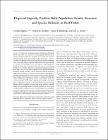| dc.contributor.author | BUCKLEY, YVONNE | en |
| dc.date.accessioned | 2014-07-08T10:11:51Z | |
| dc.date.available | 2014-07-08T10:11:51Z | |
| dc.date.issued | 2014 | en |
| dc.date.submitted | 2014 | en |
| dc.identifier.citation | Riginos, C., Buckley, Y.M., Blomberg, S.P., Treml, E.A., Dispersal capacity predicts both population genetic structure and species richness in reef fishes, The American Naturalist, 184, 1, 2014, 52 - 64 | en |
| dc.identifier.other | Y | en |
| dc.identifier.uri | http://hdl.handle.net/2262/70313 | |
| dc.description | PUBLISHED | en |
| dc.description.abstract | Dispersal is a fundamental species characteristic that should directly affect both rates of gene flow among spatially distributed populations and opportunities for speciation. Yet no single trait associated with dispersal has been demonstrated to affect both micro- and macroevolutionary patterns of diversity across a diverse biological assemblage. Here, we examine patterns of genetic differentiation and species richness in reef fishes, an assemblage of over 7,000 species comprising approximately one-third of the extant bony fishes and over one-tenth of living vertebrates. In reef fishes, dispersal occurs primarily during a planktonic larval stage. There are two major reproductive and parental investment syndromes among reef fishes, and the differences between them have implications for dispersal: (1) benthic guarding fishes lay negatively buoyant eggs, typically guarded by the male parent, and from these eggs hatch large, strongly swimming larvae; in contrast, (2) pelagic spawning fishes release small floating eggs directly into the water column, which drift unprotected before small weakly swimming larvae hatch. Using phylogenetic comparative methods, we show that benthic guarders have significantly greater population structure than pelagic spawners and additionally that taxonomic families of benthic guarders are more species rich than families of pelagic spawners. Our findings provide a compelling case for the continuity between micro- and macroevolutionary processes of biological diversification and underscore the importance of dispersalrelated traits in influencing the mode and tempo of evolution. | en |
| dc.format.extent | 52 | en |
| dc.format.extent | 64 | en |
| dc.language.iso | en | en |
| dc.relation.ispartofseries | The American Naturalist | en |
| dc.relation.ispartofseries | 184 | en |
| dc.relation.ispartofseries | 1 | en |
| dc.rights | Y | en |
| dc.subject | marine biology | en |
| dc.subject | ecology | en |
| dc.subject | evolution | en |
| dc.subject | population genetics | en |
| dc.subject | biogeography | en |
| dc.title | Dispersal capacity predicts both population genetic structure and species richness in reef fishes | en |
| dc.type | Journal Article | en |
| dc.type.supercollection | scholarly_publications | en |
| dc.type.supercollection | refereed_publications | en |
| dc.identifier.peoplefinderurl | http://people.tcd.ie/buckleyy | en |
| dc.identifier.rssinternalid | 95163 | en |
| dc.rights.ecaccessrights | openAccess | |
| dc.subject.TCDTheme | Smart & Sustainable Planet | en |
| dc.subject.TCDTag | Biodiversity and Conservation | en |
| dc.subject.TCDTag | Ecology | en |
| dc.subject.TCDTag | Environmental Impacts, Interactions | en |
| dc.identifier.rssuri | http://www.jstor.org/discover/10.1086/676505?uid=35990&uid=3738232&uid=2&uid=3&uid=67&uid=5910720&uid=35988&uid=62&sid=21103940333721 | en |
| dc.contributor.sponsor | Australian Research Council (ARC) | en |




